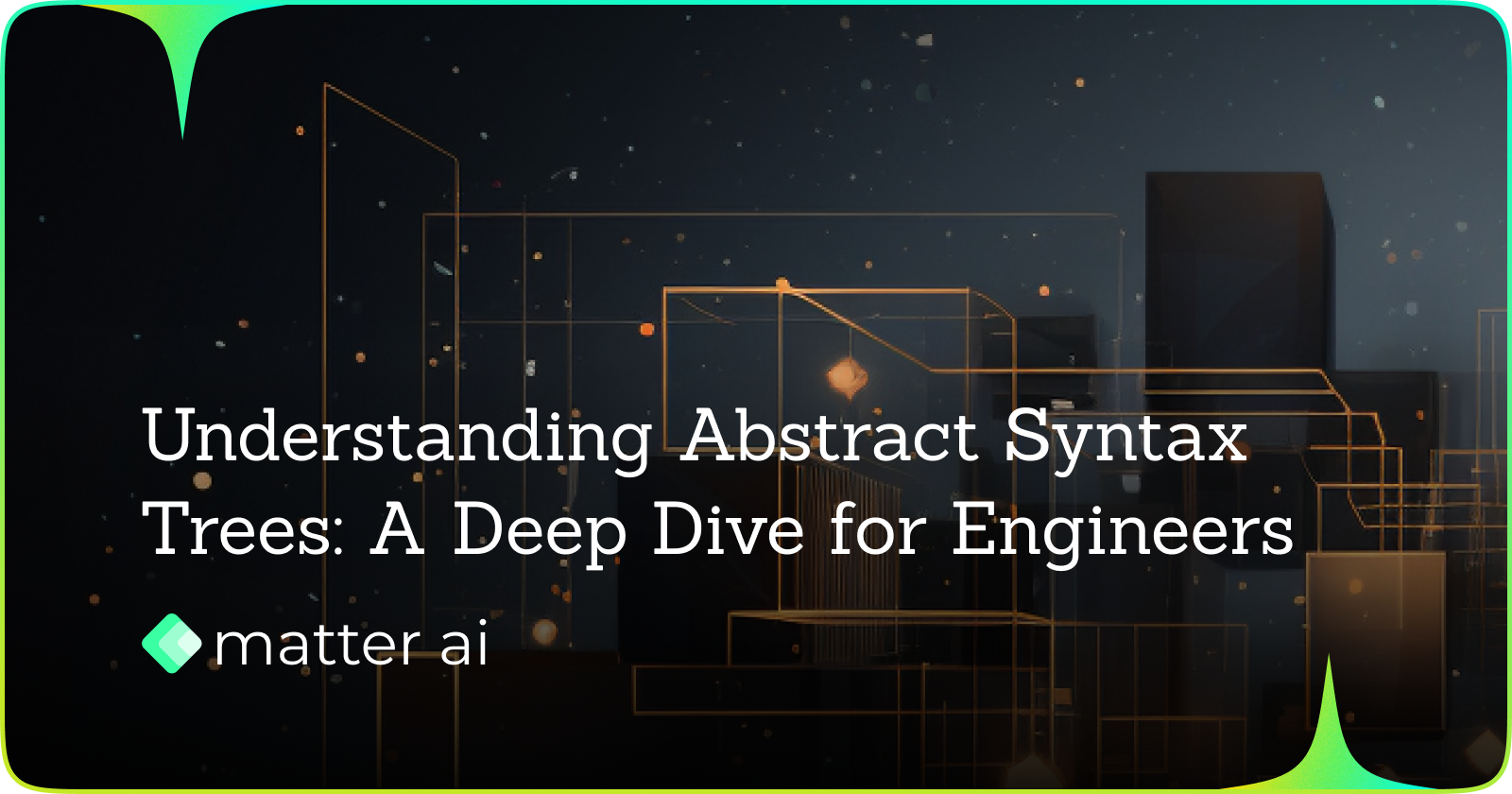Abstract Syntax Tree
Learning
Understanding Abstract Syntax Trees

Understanding Abstract Syntax Trees: A Deep Dive for Engineers
Introduction
If you've ever wondered how compilers understand your code, how linters spot bugs without running your program, or how tools like Prettier can reformat thousands of lines of code in milliseconds, you've stumbled upon one of the most powerful concepts in computer science: the Abstract Syntax Tree (AST).
While most developers interact with ASTs indirectly through their tools, understanding how they work can transform you from a tool user into a tool creator. This post will take you from AST basics to building your own code analysis tools.
What Exactly is an AST?
An Abstract Syntax Tree is a tree representation of the syntactic structure of source code. Each node in the tree represents a construct occurring in the source code. The "abstract" part means it doesn't include every detail that appears in the real syntax (like parentheses, semicolons, or whitespace)—just the structural content that matters.
Consider this simple JavaScript function:
function add(a, b) {
return a + b;
}
The AST representation would look something like:
FunctionDeclaration
├── Identifier (name: "add")
├── Params
│ ├── Identifier (name: "a")
│ └── Identifier (name: "b")
└── BlockStatement
└── ReturnStatement
└── BinaryExpression (operator: "+")
├── Identifier (name: "a")
└── Identifier (name: "b")
The Compilation Pipeline: Where ASTs Fit
Understanding where ASTs fit in the compilation process helps explain their importance:
- Lexical Analysis (Tokenization): Source code → Tokens
- Parsing: Tokens → AST
- Semantic Analysis: AST validation and type checking
- Transformation: AST → Modified AST
- Code Generation: AST → Target code
The AST serves as the central data structure that most compilation phases operate on. It's much easier to analyze and transform a tree structure than raw text.
Parsing: From Text to Tree
Let's build a simple expression parser to understand how text becomes an AST. We'll parse mathematical expressions like 2 + 3 * 4:
import re
from dataclasses import dataclass
from typing import Union, Optional
# AST Node definitions
@dataclass
class NumberNode:
value: int
@dataclass
class BinaryOpNode:
op: str
left: 'ASTNode'
right: 'ASTNode'
ASTNode = Union[NumberNode, BinaryOpNode]
class SimpleParser:
def __init__(self, text):
self.tokens = re.findall(r'\d+|[+\-*/()]', text)
self.pos = 0
def parse(self):
return self.expr()
def expr(self):
"""Parse addition and subtraction"""
left = self.term()
while self.current_token() in ['+', '-']:
op = self.current_token()
self.advance()
right = self.term()
left = BinaryOpNode(op, left, right)
return left
def term(self):
"""Parse multiplication and division"""
left = self.factor()
while self.current_token() in ['*', '/']:
op = self.current_token()
self.advance()
right = self.factor()
left = BinaryOpNode(op, left, right)
return left
def factor(self):
"""Parse numbers and parentheses"""
token = self.current_token()
if token and token.isdigit():
self.advance()
return NumberNode(int(token))
elif token == '(':
self.advance()
node = self.expr()
self.advance() # skip ')'
return node
def current_token(self):
return self.tokens[self.pos] if self.pos < len(self.tokens) else None
def advance(self):
self.pos += 1
# Example usage
parser = SimpleParser("2 + 3 * 4")
ast = parser.parse()
print(ast)
# Output: BinaryOpNode(op='+', left=NumberNode(value=2),
# right=BinaryOpNode(op='*', left=NumberNode(value=3),
# right=NumberNode(value=4)))
Working with Real ASTs
Let's explore how to work with ASTs in different languages:
JavaScript with Babel
const parser = require('@babel/parser');
const traverse = require('@babel/traverse').default;
const generate = require('@babel/generator').default;
const code = `
function greet(name) {
console.log("Hello, " + name);
}
`;
// Parse code to AST
const ast = parser.parse(code);
// Transform: Convert string concatenation to template literals
traverse(ast, {
BinaryExpression(path) {
if (path.node.operator === '+') {
const { left, right } = path.node;
// Check if it's string concatenation
if (left.type === 'StringLiteral' || right.type === 'StringLiteral') {
// Convert to template literal
path.replaceWith({
type: 'TemplateLiteral',
quasis: [
{ type: 'TemplateElement', value: { raw: left.value }, tail: false },
{ type: 'TemplateElement', value: { raw: '' }, tail: true }
],
expressions: [right]
});
}
}
}
});
// Generate code from modified AST
const output = generate(ast);
console.log(output.code);
// Output: function greet(name) { console.log(`Hello, ${name}`); }
Python's Built-in AST Module
import ast
import astor
class FunctionCallCounter(ast.NodeVisitor):
"""Count function calls in Python code"""
def __init__(self):
self.function_calls = {}
def visit_Call(self, node):
# Get function name if it's a simple call
if isinstance(node.func, ast.Name):
func_name = node.func.id
self.function_calls[func_name] = self.function_calls.get(func_name, 0) + 1
elif isinstance(node.func, ast.Attribute):
func_name = f"{astor.to_source(node.func).strip()}"
self.function_calls[func_name] = self.function_calls.get(func_name, 0) + 1
self.generic_visit(node)
code = """
def process_data(data):
result = []
for item in data:
if validate(item):
processed = transform(item)
result.append(processed)
print(f"Processed {len(result)} items")
return result
def main():
data = load_data()
processed = process_data(data)
save_data(processed)
"""
tree = ast.parse(code)
counter = FunctionCallCounter()
counter.visit(tree)
print("Function call frequency:")
for func, count in sorted(counter.function_calls.items(), key=lambda x: x[1], reverse=True):
print(f" {func}: {count}")
Building Practical Tools with ASTs
1. Custom Linter: Detecting Common Mistakes
Let's build a linter that catches a common mistake—using == instead of === in JavaScript:
const parser = require('@babel/parser');
const traverse = require('@babel/traverse').default;
function lintCode(code) {
const warnings = [];
const ast = parser.parse(code, { sourceType: 'module' });
traverse(ast, {
BinaryExpression(path) {
if (path.node.operator === '==') {
warnings.push({
line: path.node.loc.start.line,
column: path.node.loc.start.column,
message: 'Use === instead of == for strict equality'
});
}
}
});
return warnings;
}
const testCode = `
if (userInput == "admin") {
grantAccess();
}
`;
console.log(lintCode(testCode));
// Output: [{ line: 2, column: 14, message: 'Use === instead of ==' }]
2. Code Metrics Analyzer
Build a complexity analyzer using Python's AST:
import ast
class ComplexityAnalyzer(ast.NodeVisitor):
def __init__(self):
self.complexity = 0
self.current_function = None
self.function_complexities = {}
def visit_FunctionDef(self, node):
# Save previous context
prev_complexity = self.complexity
prev_function = self.current_function
# Set new context
self.current_function = node.name
self.complexity = 1 # Base complexity
# Visit function body
self.generic_visit(node)
# Store result
self.function_complexities[self.current_function] = self.complexity
# Restore context
self.complexity = prev_complexity
self.current_function = prev_function
def visit_If(self, node):
self.complexity += 1
self.generic_visit(node)
def visit_While(self, node):
self.complexity += 1
self.generic_visit(node)
def visit_For(self, node):
self.complexity += 1
self.generic_visit(node)
def visit_ExceptHandler(self, node):
self.complexity += 1
self.generic_visit(node)
def visit_With(self, node):
self.complexity += 1
self.generic_visit(node)
def visit_BoolOp(self, node):
# Add complexity for each additional boolean operator
self.complexity += len(node.values) - 1
self.generic_visit(node)
# Example usage
code = """
def process_items(items, options):
if not items:
return []
results = []
for item in items:
if item.is_valid() and (item.priority > 5 or options.force):
try:
processed = item.process()
if processed:
results.append(processed)
except ProcessingError:
if options.strict:
raise
continue
return results
"""
tree = ast.parse(code)
analyzer = ComplexityAnalyzer()
analyzer.visit(tree)
for func, complexity in analyzer.function_complexities.items():
print(f"{func}: Cyclomatic Complexity = {complexity}")
3. Auto-generating Boilerplate Code
Use ASTs to generate repetitive code patterns:
import ast
import astor
def generate_dataclass(class_name, fields):
"""Generate a Python dataclass with validation"""
# Create class definition
class_def = ast.ClassDef(
name=class_name,
bases=[],
keywords=[],
body=[],
decorator_list=[ast.Name(id='dataclass', ctx=ast.Load())]
)
# Add __post_init__ method for validation
post_init_body = []
for field_name, field_type in fields.items():
# Add type annotation
annotation = ast.AnnDef(
target=ast.Name(id=field_name, ctx=ast.Store()),
annotation=ast.Name(id=field_type, ctx=ast.Load()),
simple=1
)
# Add validation in __post_init__
if field_type == 'str':
validation = ast.If(
test=ast.UnaryOp(
op=ast.Not(),
operand=ast.Attribute(
value=ast.Name(id='self', ctx=ast.Load()),
attr=field_name,
ctx=ast.Load()
)
),
body=[
ast.Raise(
exc=ast.Call(
func=ast.Name(id='ValueError', ctx=ast.Load()),
args=[ast.Constant(value=f"{field_name} cannot be empty")],
keywords=[]
)
)
],
orelse=[]
)
post_init_body.append(validation)
# Add __post_init__ method
if post_init_body:
post_init = ast.FunctionDef(
name='__post_init__',
args=ast.arguments(
posonlyargs=[],
args=[ast.arg(arg='self', annotation=None)],
kwonlyargs=[],
kw_defaults=[],
defaults=[]
),
body=post_init_body,
decorator_list=[]
)
class_def.body.append(post_init)
# Wrap in module
module = ast.Module(body=[
ast.ImportFrom(module='dataclasses', names=[ast.alias(name='dataclass', asname=None)], level=0),
class_def
])
# Fix missing fields and generate code
ast.fix_missing_locations(module)
return astor.to_source(module)
# Generate a User dataclass
code = generate_dataclass('User', {
'name': 'str',
'email': 'str',
'age': 'int'
})
print(code)
Performance Considerations
When working with ASTs in production:
-
Parse Once, Transform Many: Parsing is expensive. Cache ASTs when possible.
-
Visitor vs. Transformer Pattern: Use visitors for analysis (read-only), transformers for modifications.
-
Incremental Parsing: For large codebases, consider incremental parsing strategies that only re-parse changed portions.
-
Memory Usage: ASTs can be memory-intensive. For large files, consider streaming or chunking approaches.
Common Pitfalls and Best Practices
Pitfall 1: Modifying While Traversing
# Wrong: Modifying list while iterating
for node in ast.walk(tree):
if isinstance(node, ast.FunctionDef):
tree.body.remove(node) # Don't do this!
# Right: Collect first, then modify
functions_to_remove = []
for node in ast.walk(tree):
if isinstance(node, ast.FunctionDef):
functions_to_remove.append(node)
for func in functions_to_remove:
tree.body.remove(func)
Pitfall 2: Losing Source Information
Always preserve location information when transforming ASTs if you need to provide meaningful error messages:
new_node = ast.Name(id='new_var', ctx=ast.Load())
ast.copy_location(new_node, old_node) # Preserve line/column info
Pitfall 3: Language-Specific Quirks
Each language's AST has quirks. JavaScript's AST differentiates between expressions and statements, Python's AST requires fixing missing locations, and Go's AST preserves comments as separate entities.
Advanced Applications
1. Cross-Language Transpilation
ASTs enable transpilation between languages with similar semantics. Tools like Transcrypt (Python to JavaScript) work by converting Python AST to JavaScript AST.
2. Program Synthesis
Generate code from specifications by constructing ASTs programmatically, then converting to source code.
3. Differential Testing
Compare ASTs of different implementations to ensure semantic equivalence during refactoring.
4. Security Analysis
Detect security vulnerabilities by pattern matching against known vulnerable AST patterns (taint analysis, SQL injection detection).
Tools and Resources
AST Explorers
- AST Explorer (astexplorer.net): Interactive AST visualization for multiple languages
- Python AST Visualizer: Built-in
ast.dump()withindentparameter - Babel AST Explorer: Specific to JavaScript/TypeScript
Libraries
- JavaScript/TypeScript: Babel, Acorn, Esprima, TypeScript Compiler API
- Python: ast (built-in), astroid, RedBaron
- Go: go/ast, go/parser packages
- Rust: syn, quote crates
- Java: JavaParser, Eclipse JDT
Learning Resources
- "Writing An Interpreter In Go" by Thorsten Ball
- "Crafting Interpreters" by Robert Nystrom
- Dragon Book: "Compilers: Principles, Techniques, and Tools"
Conclusion
Abstract Syntax Trees are the backbone of modern development tooling. Understanding them transforms mysterious "magic" into comprehensible engineering. Whether you're building a simple linter, a complex refactoring tool, or even your own programming language, ASTs provide the foundation you need.
Start small—pick a simple problem in your codebase that could benefit from automated analysis or transformation. Parse it into an AST, traverse it, and see what patterns emerge. You'll be surprised how many "impossible" problems become tractable when you're working with structured data instead of text.
The next time you use a development tool that seems to understand your code, remember: it's not magic, it's trees all the way down.
Learn more on how Matter AI helps improve code quality across multiple languages in Pull Requests: https://docs.matterai.so/product/code-quality
Are you looking for a way to improve your code review process? Learn more on how Matter AI helps team to solve code review challenges with AI: https://matterai.so
Share this Article:
More Articles

AI Engineering Productivity: Transforming Software Development
Artificial intelligence isn't just another tool in the developer's toolkit—it's fundamentally changing how we approach problem-solving, code creation, and system design.

How to Improve the PR Review Process for Engineering Teams
Let's dive deep into the PR review process and see how we can improve it

Introducing Matter AI Code Reviews for VSCode, Cursor, CLine and more
Matter AI MCP for Cursor to get real-time code reviews

Understanding Attention: Coherency in LLMs
How LLMs generate coherent text across long contexts

LLM Tokenisation fundamentals and working
What is LLM Tokenisation and how it works
Continue Reading

AI Engineering Productivity: Transforming Software Development
Artificial intelligence isn't just another tool in the developer's toolkit—it's fundamentally changing how we approach problem-solving, code creation, and system design.

How to Improve the PR Review Process for Engineering Teams
Let's dive deep into the PR review process and see how we can improve it

Introducing Matter AI Code Reviews for VSCode, Cursor, CLine and more
Matter AI MCP for Cursor to get real-time code reviews
